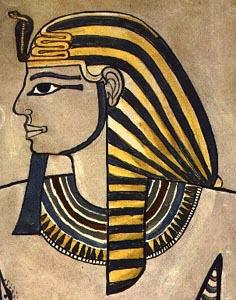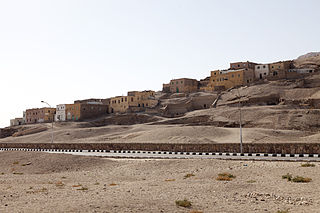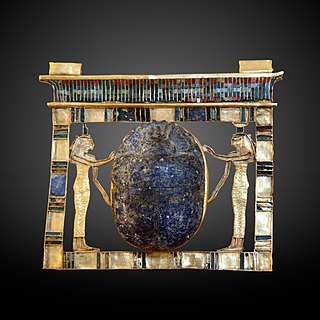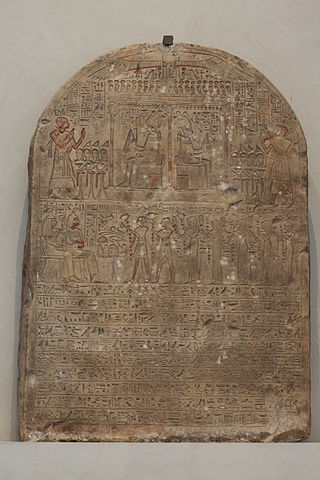Related Research Articles

Amenhotep III, also known as Amenhotep the Magnificent or Amenhotep the Great and Hellenized as Amenophis III, was the ninth pharaoh of the Eighteenth Dynasty. According to different authors, he ruled Egypt from June 1386 to 1349 BC, or from June 1388 BC to December 1351 BC/1350 BC, after his father Thutmose IV died. Amenhotep was Thutmose's son by a minor wife, Mutemwiya.
Thutmose is an anglicization of the ancient Egyptian personal name dhwty-ms, usually translated as "Born of the god Thoth".

Amenhotep II was the seventh pharaoh of the Eighteenth Dynasty of Egypt. He inherited a vast kingdom from his father Thutmose III, and held it by means of a few military campaigns in Syria; however, he fought much less than his father, and his reign saw the effective cessation of hostilities between Egypt and Mitanni, the major kingdoms vying for power in Syria. His reign is usually dated from 1427 to 1401 BC. His consort was Tiaa, who was barred from any prestige until Amenhotep's son, Thutmose IV, came into power.

The necropolis of El-Khokha is located on the west bank of the river Nile at Thebes, Egypt. The necropolis is surrounds a hill and has five Old Kingdom tombs and over 50 tombs from the 18th, 19th and 20th dynasties as well as some from the First Intermediate Period and the Late Period.

Thutmose was the eldest son of Pharaoh Amenhotep III and Queen Tiye, who lived during the Eighteenth Dynasty of Egypt. His early death led to the reign of Akhenaten, his younger brother—as the successor to the Egyptian throne—and the intrigues of the century leading up to Ramesses II, the start and ultimately the failure of Atenism, the Amarna letters, and the changing roles of the kingdom's powers.

Qurnet Murai is a necropolis located on the West Bank of the Nile at Thebes, Egypt, just to the south of Sheikh Abd el-Qurna.

Paser was an ancient Egyptian noble who served as vizier during the reigns of Seti I and Ramesses II in the 19th Dynasty. He would later also become High Priest of Amun.
Ptahmose or Ptahmes may refer to:

Ptahmose was a High Priest of Amun and Vizier of southern Egypt-(Upper Egypt), under Amenhotep III. Certain historians place him at the end of the reign in 1378 BC. Others place him in the first part of the reign.
Amenhotep was an ancient Egyptian prince during the 18th Dynasty, son and (possibly) the designated heir of Amenhotep II.

The High Priest of Ptah was sometimes referred to as "the Greatest of the Directors of Craftsmanship". This title refers to Ptah as the patron god of the craftsmen.
Meryptah was a High Priest of Amun during the time of Amenhotep III.
Maya or May was a High Priest of Amun of ancient Egypt, until at least year 4 of Akhenaten.

Ptahmose was High Priest of Ptah in Memphis during the time of Thutmose III of the 18th Dynasty.
Ptahmose was High Priest of Ptah in Memphis during the time of Thutmose IV. Ptahmose held the titles of High Priest of Ptah in the two houses (pr.wy), he who is over the secrets of the great [..] and of foremost position in Rostau.

Ptahmose was High Priest of Ptah in Memphis during the time of Thutmose IV and/or Amenhotep III. He was the son of a Prophet (priest) named Menkheper. Ptahmose's son Pahonte would later serve as High Priest of Ptah.
This page list topics related to ancient Egypt.
Thutmose was an ancient Egyptian vizier under Amenhotep III, during the 18th Dynasty.

The Genealogy of Ankhefensekhmet or Genealogy of the Memphite priestly elite is an ancient Egyptian relief – sometimes referred to as a stela – normally identified as having been made during the 8th century BCE, under the reign of pharaoh Shoshenq V of the late 22nd Dynasty. A surviving block is kept at the Egyptian Museum of Berlin. The relief was issued by a priest called Ankhefensekhmet with the purpose of illustrating his own genealogy. The relief traces back Ankhefensekhmet's sequence of ancestors up to 64 generations before, with the earliest individual, Ptahemheb, identified by Ritner as being from the time of Nebhepetre of the 11th Dynasty and alternatively identified by Borchart as being from the time of Nebkaure Khety of the 10th Dynasty. On 25 occasions the genealogy also names the pharaoh or king who was ruling at the time.
Hui or Huy was an ancient Egyptian name, frequently a nickname for Amenhotep.
References
- ↑ K. Bosse-Griffiths, The Memphite Stela of Merptaḥ and Ptaḥmosĕ, The Journal of Egyptian Archaeology, Vol. 41 (Dec., 1955), pp. 56-63
- ↑ O'Connor and Cline (Eds), Amenhotep III: Perspectives on his reign, 2001, pg 210